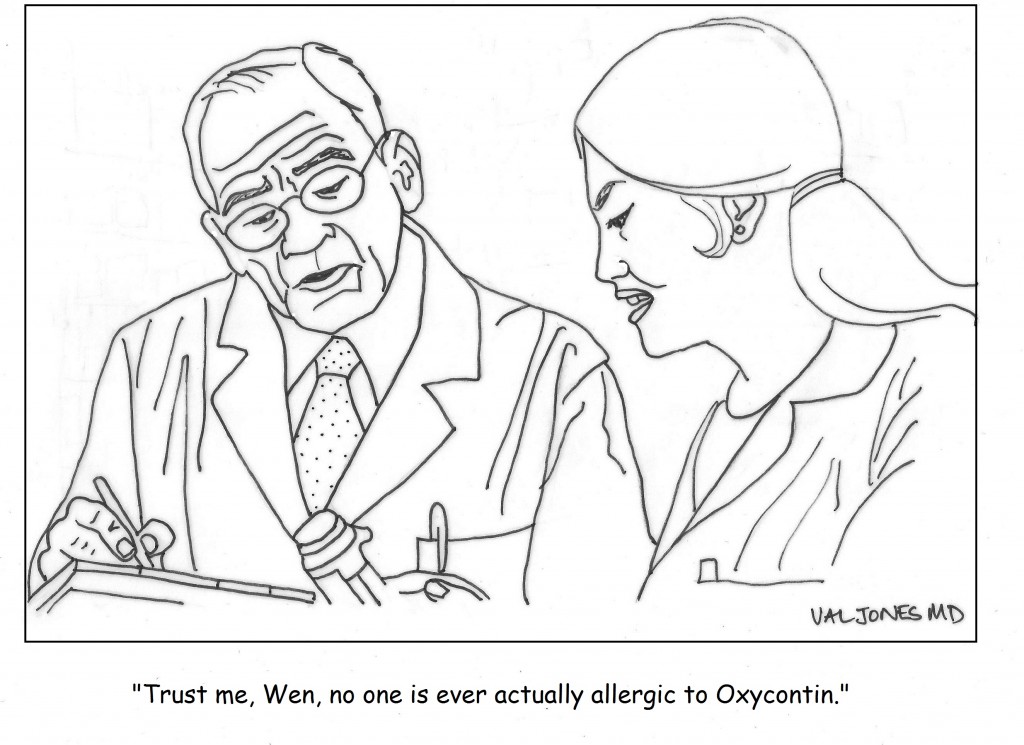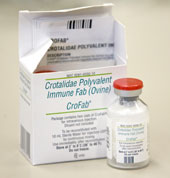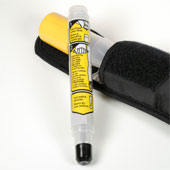Cartoon: America’s Problem With Pain Meds


 The current standard of care with regard to using antivenom for pit viper snakes (e.g., rattlesnakes, copperheads, cottonmouths) in North America is to use Crotalidae polyvalent immune Fab antivenom (CroFab;FabAV). This antivenom is created using a process that obtains antibodies “raised” by immunizing sheep and then harvesting and purifying the product. One of the major benefits of using this product is to take advantage of a lesser incidence of allergic reactions (than have traditionally been observed with previous products). It appears that the situation regarding the incidence of allergic reactions may be better than previously thought.
The current standard of care with regard to using antivenom for pit viper snakes (e.g., rattlesnakes, copperheads, cottonmouths) in North America is to use Crotalidae polyvalent immune Fab antivenom (CroFab;FabAV). This antivenom is created using a process that obtains antibodies “raised” by immunizing sheep and then harvesting and purifying the product. One of the major benefits of using this product is to take advantage of a lesser incidence of allergic reactions (than have traditionally been observed with previous products). It appears that the situation regarding the incidence of allergic reactions may be better than previously thought.
In the article, “Short Term Outcomes After Fab Antivenom Therapy for Severe Crotaline Snakebite,” Eric Lavonas, MD and colleagues (Ann Emerg Med 2011;57:128-137) examined Read more »
This post, Fab Antivenom Found To Cause Fewer Allergic Reactions Than Previously Thought, was originally published on Healthine.com by Paul Auerbach, M.D..
 An allergic reaction in an outdoor setting can rapidly become a life-threatening emergency. While most of us think of food allergies as annoyances, they can be quite serious or even life threatening. Itchy skin rashes can progress to breathing difficulty, swollen soft tissues (e.g., lips, tongue, throat) that compromise the airway, and low blood pressure or even shock. Therefore, it’s important to be familiar with the signs and symptoms of severe allergy and to be prepared to respond rapidly in the event of an emergency.
An allergic reaction in an outdoor setting can rapidly become a life-threatening emergency. While most of us think of food allergies as annoyances, they can be quite serious or even life threatening. Itchy skin rashes can progress to breathing difficulty, swollen soft tissues (e.g., lips, tongue, throat) that compromise the airway, and low blood pressure or even shock. Therefore, it’s important to be familiar with the signs and symptoms of severe allergy and to be prepared to respond rapidly in the event of an emergency.
An EpiPen (an epinephrine auto-injector)
The National Institute of Allergy and Infectious Diseases has released Food Allergy Guidelines for healthcare professionals to help guide the care of patients with life-threatening food allergies. The full guidelines can be found at http://www.niaid.nih.gov/topics/foodallergy/clinical/Pages/default.aspx. Here are some key points: Read more »
This post, Food Allergies: Treating Severe Allergic Reactions, was originally published on Healthine.com by Paul Auerbach, M.D..
Bioadhesives are a reasonable alternative to sutures for repair of perineal lacerations sustained during childbirth, according to a poster presentation at last week’s annual meeting of the Society for Maternal-Fetal Medicine.
Researchers at the Hadassah Hebrew University Medical Center in Jerusalem randomized women with first degree perineal tears to either 2-octyl cyanoacrylate (Dermabond) adhesive glue or suture for wound closure. While healing and incisional pain was similar, women who received the adhesive closure were more satisfied than those who were sutured.
In Portugal, bioadhesives have been studied for closure of the top skin layer of an episiotomy repair, and found to shorten the duration of the procedure with similar outcomes to suture in terms of pain, healing, and infection.
Biologic adhesives are chemically related to Super Glue, which is ethyl-cyanoacrylate. Midwives have been using Super Glue for perineal wound repair for some time, according to Anne Frye, who has authored a book on wound closure for midwives, and who gives instructions for its use in repair of perineal lacerations. Apparently Super Glue was also used by the military during Vietnam for wound closure.
A PubMed search on Dermabond finds multiple studies of its use, from plastic surgery to mastectomy, surgical wound closure, retinal surgery, lung and gastric leak closure, and even on esophageal varices. RL Bates mentions Dermabond as an option to repair skin tears in elderly patients. This stuff is turning into the duct tape of the medical profession.
It’s important to remember that adhesives are only for superficial skin closure, as use in deeper layers can cause irritation and burning of tissues. Side effects of their use include irritation and allergic reactions and of course wound infections, and pain can always occur no matter how one closes a wound.
*This blog post was originally published at The Blog That Ate Manhattan*
“All natural. Certified organic. Made from natural ingredients. Pure botanicals. Chemical free.”
You might guess I’m standing in the farmers market. Nope. I’m in the “Health and Beauty” aisle at Target. The ubiquitous all-things-natural trend has overtaken the cosmetic industry. How do you know what’s real and what’s marketing hype? Here are five things you should know about organic beauty product labels:
1. Labels that say “natural ingredients” or “botanicals” are not certified organic. These statements are not regulated. Most natural ingredients used in beauty products are actually modified in a lab. Truly botanical ingredients, like you’d pick in your garden, are usually unstable and would spoil like food.
2. Natural doesn’t always mean better. Would you buy: Poison Ivy Eye-Cream? Stinging Nettles Anti-Itch Gel? The most toxic and allergy-inducing ingredients are naturally occurring substances, not manufactured ones. Read more »
*This blog post was originally published at The Dermatology Blog*
It’s no secret that doctors are disappointed with the way that the U.S. healthcare system is evolving. Most feel helpless about improving their work conditions or solving technical problems in patient care. Fortunately one young medical student was undeterred by the mountain of disappointment carried by his senior clinician mentors…
I am proud to be a part of the American Resident Project an initiative that promotes the writing of medical students residents and new physicians as they explore ideas for transforming American health care delivery. I recently had the opportunity to interview three of the writing fellows about how to…
Book Review: Is Empathy Learned By Faking It Till It’s Real?

I m often asked to do book reviews on my blog and I rarely agree to them. This is because it takes me a long time to read a book and then if I don t enjoy it I figure the author would rather me remain silent than publish my…
The Spirit Of The Place: Samuel Shem’s New Book May Depress You

When I was in medical school I read Samuel Shem s House Of God as a right of passage. At the time I found it to be a cynical yet eerily accurate portrayal of the underbelly of academic medicine. I gained comfort from its gallows humor and it made me…
Eat To Save Your Life: Another Half-True Diet Book

I am hesitant to review diet books because they are so often a tangled mess of fact and fiction. Teasing out their truth from falsehood is about as exhausting as delousing a long-haired elementary school student. However after being approached by the authors’ PR agency with the promise of a…